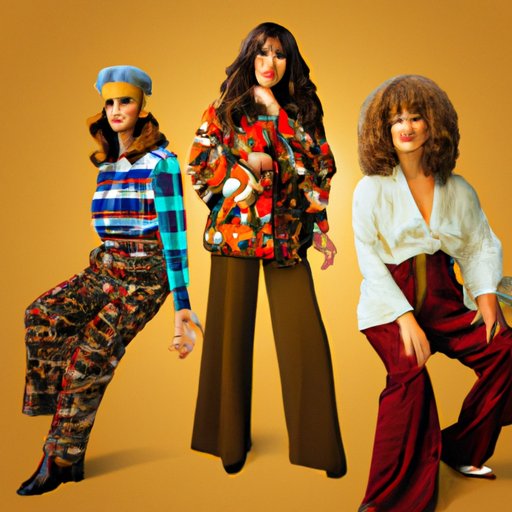Introduction
The 1970s was a decade of bold fashion statements and cultural movements. From the hippie-chic of the early years to the glam rock looks of the mid-70s, this decade left a lasting mark on fashion culture. But what exactly made 70s fashion so unique? In this article, we’ll explore the iconic styles and trends that defined the decade, as well as how you can easily recreate the look in the modern age.
Re-living the 70s: Popular Fashions of the Decade
The 70s was a time of experimentation and exploration when it came to fashion. From the rise of the disco movement to the emergence of boho style, there were many distinct trends that shaped the decade.
Disco Style
In the mid-70s, the disco scene exploded onto the music and fashion scenes. Disco style was all about glitz and glamour, featuring bright colors, flashy prints, and lots of sequins and sparkles. Women often wore tight-fitting jumpsuits or dresses with plunging necklines, while men sported wide-collared shirts and platform shoes. This look quickly became a staple of the decade.
Hippie-Chic
The hippie movement of the late 60s had a strong influence on 70s fashion. The style was easy-going and laidback, featuring flowy fabrics, loose silhouettes, and earthy colors. Common items included peasant blouses, bell-bottom jeans, and fringe jackets. This trend was especially popular among the youth of the time.
Boho Style
The bohemian trend emerged in the early 70s and was characterized by free-spirited, eclectic pieces. This style featured light, airy fabrics like cotton and linen, along with ethnic prints and embroidery. Popular items included long skirts, maxi dresses, and tunics. This look was embraced by both men and women and was often seen at music festivals.
Glam Rock
Glam rock was an incredibly popular style in the mid-70s. It was heavily influenced by the glam rock bands of the time, such as David Bowie, Alice Cooper, and T. Rex. Glam rock style was all about pushing the boundaries of fashion with outrageous outfits and daring makeup. Men often wore skinny jeans, platform shoes, and flamboyant shirts, while women opted for tight-fitting jumpsuits and leotards.

Exploring the Retro Glamour of 70s Fashion
One of the most iconic aspects of 70s fashion was its focus on accessorizing. Chunky jewelry, statement sunglasses, and bold belts were all popular accessories of the era. Women also loved wearing scarves and headbands, while men often opted for wide-brimmed hats and aviator glasses.
Makeup was also a big part of the 70s style. Heavy eyeliner and bright lipstick were staples of the decade, as were shimmery eyeshadows and rosy cheeks. This look was often paired with long, voluminous hair, either naturally curly or straightened with a curling iron.

How to Recreate 70s Style for the Modern Age
If you’re looking to bring back the spirit of the 70s, there are a few tips you can follow to help you recreate the look. To start, opt for clothing with a looser fit and more relaxed silhouette. Wide-legged pants, oversized blazers, and A-line skirts are all great options. You can also add a bit of flare with bold accessories like statement earrings and wide-brimmed hats.
When it comes to shopping for 70s-inspired pieces, there are plenty of stores that carry vintage-inspired items. Online retailers like ASOS, Topshop, and Urban Outfitters all offer a variety of 70s-style clothing. You can also find great deals at thrift stores and vintage shops.
70s Fashion: What Made It so Unique?
So what made 70s fashion so special? A lot of it had to do with the cultural influences of the time. The 70s saw the emergence of new music genres, such as punk and disco, which greatly impacted the way people dressed. The decade was also marked by a growing sense of individualism and self-expression, which encouraged people to experiment with their style.
Materials also played a major role in the fashion of the 70s. Polyester was widely used during this time, making it easier to create bright colors and bold patterns. Synthetic fabrics like spandex and lycra were also becoming increasingly popular, allowing for more form-fitting silhouettes.
Key Pieces of 70s Fashion You Need in Your Wardrobe
If you’re looking to recreate 70s style, there are a few key pieces you should have in your wardrobe. Denim is always a must-have—think flared jeans, jean jackets, and denim skirts. Platform shoes are also essential, as they were a staple of the decade. Lastly, maxi dresses are a great way to channel the free-spirited vibe of the era.

How the 70s Changed Fashion Forever
It’s no secret that the 70s had a huge impact on fashion culture. The decade saw the emergence of new materials, silhouettes, and trends that still influence today’s fashion. Many of these styles, such as bell-bottom jeans and maxi dresses, remain popular to this day. The decade also saw the rise of the designer label, with iconic labels like Yves Saint Laurent and Halston gaining immense popularity.
The 70s was a time of self-expression and creativity, and its influence can still be seen in today’s fashion. Whether you’re looking to recreate classic looks or just add a touch of retro glamour to your wardrobe, 70s fashion is sure to inspire.
Conclusion
From disco style to hippie-chic, 70s fashion was full of bold statements and unique styles. This decade left a lasting mark on fashion culture, and its influence can still be seen in today’s trends. With a few key pieces and some creative styling, you can easily recreate the look of the 70s.
(Note: Is this article not meeting your expectations? Do you have knowledge or insights to share? Unlock new opportunities and expand your reach by joining our authors team. Click Registration to join us and share your expertise with our readers.)
